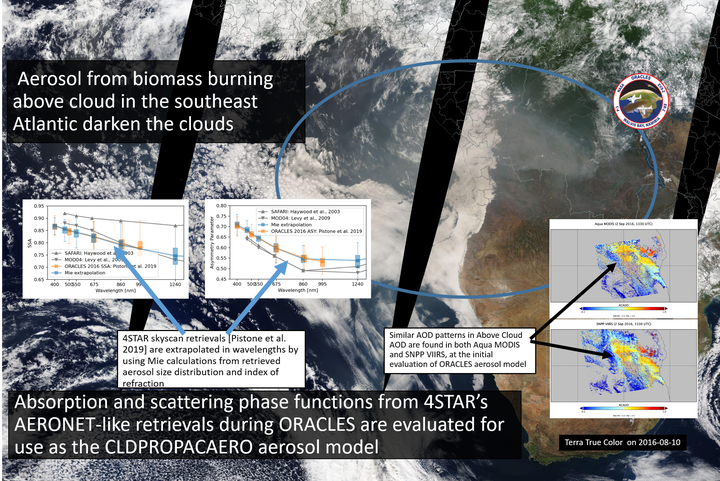AGU Fall 2022 Oral Presentation
 ORACLES data for improving ACAERO MODIS continuity products snippet from oral presentation AGU Fall meeting 2022
ORACLES data for improving ACAERO MODIS continuity products snippet from oral presentation AGU Fall meeting 2022Abstract
When aerosol overlie bright clouds, their radiative impact on the incident light can be either positive or negative. This difference in radiative impact promotes difficulties in remote sensing aerosol properties, which have shown biases in aerosol optical depth (AOD) retrievals when clouds are underneath. To better constrain this quantity, we have measured aerosols above clouds over the course of 3 years in the southeast Atlantic as part of the ObseRvations of CLouds above Aerosols and their intEractionS (ORACLES). These directly measured AOD above clouds are used to build and improve upon the current Near-Real-Time MODACAERO algorithm for above cloud AOD from MODIS, into a continuity product for NASA EOS/SNPP/JPSS. Here we present a summary of the above cloud aerosol optical depth measured during ORACLES, and that will be used for porting the MODACAERO algorithm to the continuity product. We use aerosol optical depth measured directly from sunlight attenuation using the Spectrometer for Sky-Scanning, Sun-Tracking Atmospheric Research (4STAR) and compare it to the active remote sensing, High Spectral Resolution Lidar-2 (HSRL-2). We present a combination of all 3 years of measurements during peak biomass burning season. We have observed average above cloud aerosol optical depth at 500 nm ranging from 0.28 to 0.37, with the maximum in August 2017. We emphasize the use of improved aerosol absorption and scattering models based on airborne measurements during ORACLES.